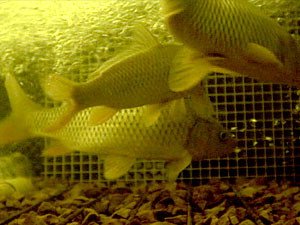Cacophony may curb carp

A noisy bubble barrier holds potential for slowing fish's spread
It belongs to the minnow family, but it does a whale of a lot of damage.
It's the common carp, a fish with the nasty habit of rooting around in sediments, stirring up mud and nutrients that cause algae to bloom and water quality to take a dive.
"They're probably the number one water quality problem in Minnesota," says University of Minnesota fisheries professor Peter Sorensen. "Hundreds of thousands of duck-hunting acres have also been destroyed by common carp. In many lakes, up to three-quarters of the fish biomass is carp."
Sorensen is part of a University team testing a new method of hindering the spread of young carp. They're pitted against a fish that makes up in brains for what it lacks in beauty.
A few years ago, Sorensen and research associate Przemyslaw Bajer discovered that adult carp spend the winter in deep lakes where there's no "winterkill" from lack of oxygen. In the spring, they move through connecting waterways into shallow lakes that are likely to have suffered winterkill; if so, those lakes will be free of the native fish that can eat every last carp egg. After spawning in the shallow "nursery" lakes, the adults leave, all unerringly finding their way back to their home lakes.
Their juvenile offspring leave, too, because if they don't, they could also fall victim to the winterkills that plague shallow waters. They escape by swimming downstream and using the lakes' outlets as conduits into new lakes. As yet, no technology can stop these downstream migrations; neither grates nor dangerous, expensive electrical barriers do the job.
But a wall of cheap, harmless bubbles just might—at least well enough to have a significant benefit. And that's what Sorensen and his colleagues are testing.
Bubble trouble
In laboratory tests, the research team placed young carp in a circular channel within a large tank. At one point in the channel the researchers had laid plastic tubes, all containing holes like a flute, across the bottom. As air was pumped into the tubes, a roiling curtain of bubbles rose from the holes. Each experiment used three carp, one of which carried a chip that emitted radio signals to antennas on either side of the bubble curtain to record when the fish (and its buddies, since they tend to stick together) passed through it.
"We saw a reduction of 70 to 80 percent in the number of passages downstream through the bubble barrier," says civil engineering professor and team member Vaughan Voller.
If a bubble barrier should slow young carp's progress in the wild, they would likely be repelled not necessarily by the sight of the bubbles, but rather by the sound pressure and/or turbulence the bubbling generates, Voller says. Carp have a very sensitive hearing system, and the bubble curtain can efficiently and cheaply crank out about 130 decibels underwater, similar to what you would experience standing one meter from a jackhammer.
At the University's St. Anthony Falls Laboratory (SAFL), graduate student Daniel Zielinski is studying whether a bubble barrier will deter carp in an artificial waterway. This summer he ran preliminary tests of a barrier at SAFL's Outdoor Stream Lab, which diverts Mississippi River water into a narrow stream coursing across a small island.
"I run the experiments overnight to eliminate visual cues from the bubbles," says Zielinski, who has scheduled more experiments for October. If all goes well, bubble barriers could be installed for field tests in Twin Cities lakes. Sorensen is working with officials in two metro-area watersheds: Ramsey Metro Washington in the east and Riley Creek Purgatory Bluff in the west, both of which have significant water quality issues.
Wily wrigglers
Whatever happens, carp will never completely go away, Sorensen says.
"People may have assumed these are stupid fish, but they're very smart—seemingly much smarter than many local fish," he notes. "They've evolved this sneaky strategy of getting into these [nursery] lakes where no other fish are, spawning millions of eggs, and then getting out. There's no strategy like that among the native fish.
"Commercial fishermen say that if there's a hole in your net, you're cooked, because once one carp finds it, the others will follow it out."
And if you're wondering what's being done about the common carp's big, destructive cousin, the Asian carp, this fall Sorensen is involved in lab tests at the University and field tests in Missouri.
"The field tests will be to see if Asian carp pheromones can be used to lure them into traps," he says. "Also, I think anything we discover regarding sound and repulsion in common carp will be applicable to the Asian carp, which also has an excellent sense of hearing that is far more acute than those of almost all native fish."
Or maybe we could solve all our carp problems with a knife and fork.
"They're good eating if they're fresh," Sorensen attests, but adds that he doubts the country could consume enough to make much of a difference.
Principal investigators in the common carp research are Sorensen, Voller, Allen Mensinger at the U of M Duluth campus, and Miki Hondzo at SAFL. The Legislative Citizen Commission on Minnesota Resources funds the SAFL barrier work.
